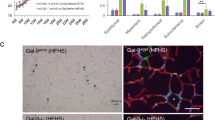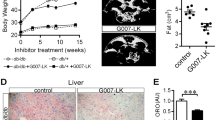Abstract
Glutathione transferase Kappa (GSTK1-1) also termed disulfide bond-forming oxidoreductase A-like protein (DsbA-L) has been implicated in the post-translational multimerization of adiponectin and has been negatively correlated with obesity in mice and humans. We investigated adiponectin in Gstk1−/− mice and surprisingly found no difference in the levels of total serum adiponectin or the level of high molecular weight (HMW) multimers when compared with normal controls. Non-reducing SDS-polyacrylamide gel electrophoresis and western blotting also showed a similar distribution of low, middle and HMW multimers in normal and Gstk1−/− mice. Variation in adiponectin has been correlated with glucose tolerance and with the levels of phosphorylated AMP-kinase but we found similar glucose tolerance and similar levels of phospho 5-AMP-activated protein kinase in normal and Gstk1−/− mice. Consequently, our findings suggest that GSTK1-1 is not absolutely required for adiponectin multimerization in vivo and alternate pathways may be activated in GSTK1-1 deficiency.
This is a preview of subscription content, access via your institution
Access options
Subscribe to this journal
Receive 12 print issues and online access
$259.00 per year
only $21.58 per issue
Buy this article
- Purchase on Springer Link
- Instant access to full article PDF
Prices may be subject to local taxes which are calculated during checkout

Similar content being viewed by others
References
Wang Y, Lam KS, Yau MH, Xu A . Post-translational modifications of adiponectin: mechanisms and functional implications. Biochem J 2008; 409: 623–633.
Weyer C, Funahashi T, Tanaka S, Hotta K, Matsuzawa Y, Pratley RE et al. Hypoadiponectinemia in obesity and type 2 diabetes: close association with insulin resistance and hyperinsulinemia. J Clin Endocrinol Metab 2001; 86: 1930–1935.
Yatagai T, Nagasaka S, Taniguchi A, Fukushima M, Nakamura T, Kuroe A et al. Hypoadiponectinemia is associated with visceral fat accumulation and insulin resistance in Japanese men with type 2 diabetes mellitus. Metabolism 2003; 52: 1274–1278.
Kadowaki T, Yamauchi T, Kubota N, Hara K, Ueki K, Tobe K . Adiponectin and adiponectin receptors in insulin resistance, diabetes, and the metabolic syndrome. J Clin Invest 2006; 116: 1784–1792.
Ohashi K, Kihara S, Ouchi N, Kumada M, Fujita K, Hiuge A et al. Adiponectin replenishment ameliorates obesity-related hypertension. Hypertension 2006; 47: 1108–1116.
Okamoto Y, Kihara S, Ouchi N, Nishida M, Arita Y, Kumada M et al. Adiponectin reduces atherosclerosis in apolipoprotein E-deficient mice. Circulation 2002; 106: 2767–2770.
Xu A, Wang Y, Keshaw H, Xu LY, Lam KS, Cooper GJ . The fat-derived hormone adiponectin alleviates alcoholic and nonalcoholic fatty liver diseases in mice. J Clin Invest 2003; 112: 91–100.
Pajvani UB, Hawkins M, Combs TP, Rajala MW, Doebber T, Berger JP et al. Complex distribution, not absolute amount of adiponectin, correlates with thiazolidinedione-mediated improvement in insulin sensitivity. J Biol Chem 2004; 279: 12152–12162.
Liu M, Zhou L, Xu A, Lam KS, Wetzel MD, Xiang R et al. A disulfide-bond A oxidoreductase-like protein (DsbA-L) regulates adiponectin multimerization. Proc Natl Acad Sci USA 2008; 105: 18302–18307.
Thomson RE, Bigley AL, Foster JR, Jowsey IR, Elcombe CR, Orton TC et al. Tissue-specific expression and subcellular distribution of murine glutathione S-transferase class kappa. J Histochem Cytochem 2004; 52: 653–662.
Morel F, Rauch C, Petit E, Piton A, Theret N, Coles B et al. Gene and protein characterization of the human glutathione S-transferase kappa and evidence for a peroxisomal localization. J Biol Chem 2004; 279: 16246–16253.
Morel F, Aninat C . The glutathione transferase kappa family. Drug Metab Rev 2011; 43: 281–291.
Robinson A, Huttley GA, Booth HS, Board PG . Modelling and bioinformatics studies of the human Kappa class glutathione transferase predict a novel third glutathione transferase family with homology to prokaryotic 2-hydroxychromene-2-carboxylate (HCCA) isomerases. Biochem J 2004; 379 (Pt 3): 541–552.
Ladner JE, Parsons JF, Rife CL, Gilliland GL, Armstrong RN . Parallel evolutionary pathways for glutathione transferases: structure and mechanism of the mitochondrial class kappa enzyme rGSTK1-1. Biochemistry 2004; 43: 352–361.
Blackburn AC, Coggan M, Shield AJ, Cappello J, Theodoratos A, Murray TP et al. Glutathione transferase kappa deficiency causes glomerular nephropathy without overt oxidative stress. Lab Invest 2011; 91: 1572–1583.
Sharma K, Ramachandrarao S, Qiu G, Usui HK, Zhu Y, Dunn SR et al. Adiponectin regulates albuminuria and podocyte function in mice. J Clin Invest 2008; 118: 1645–1656.
Ebinuma H, Miida T, Yamauchi T, Hada Y, Hara K, Kubota N et al. Improved ELISA for selective measurement of adiponectin multimers and identification of adiponectin in human cerebrospinal fluid. Clin Chem 2007; 53: 1541–1544.
Bullen Jr JW, Bluher S, Kelesidis T, Mantzoros CS . Regulation of adiponectin and its receptors in response to development of diet-induced obesity in mice. Am J Physiol Endocrinol Metab 2007; 292: E1079–E1086.
Yamauchi T, Kamon J, Minokoshi Y, Ito Y, Waki H, Uchida S et al. Adiponectin stimulates glucose utilization and fatty-acid oxidation by activating AMP-activated protein kinase. Nat Med 2002; 8: 1288–1295.
Kadowaki T, Yamauchi T, Kubota N . The physiological and pathophysiological role of adiponectin and adiponectin receptors in the peripheral tissues and CNS. FEBS Lett 2008; 582: 74–80.
Acknowledgements
These studies were undertaken with the financial support of NHMRC Grant 418071, an NHMRC RD Wright Fellowship to AB and an NHMRC Australian Biomedical (Peter Doherty) Fellowship to CL.
Author information
Authors and Affiliations
Corresponding author
Ethics declarations
Competing interests
The authors declare no conflict of interest.
Rights and permissions
About this article
Cite this article
Theodoratos, A., Blackburn, A., Coggan, M. et al. The impact of glutathione transferase kappa deficiency on adiponectin multimerisation in vivo. Int J Obes 36, 1366–1369 (2012). https://doi.org/10.1038/ijo.2011.267
Received:
Revised:
Accepted:
Published:
Issue Date:
DOI: https://doi.org/10.1038/ijo.2011.267
Keywords
This article is cited by
-
Assembly of adiponectin oligomers
Reviews in Endocrine and Metabolic Disorders (2014)



